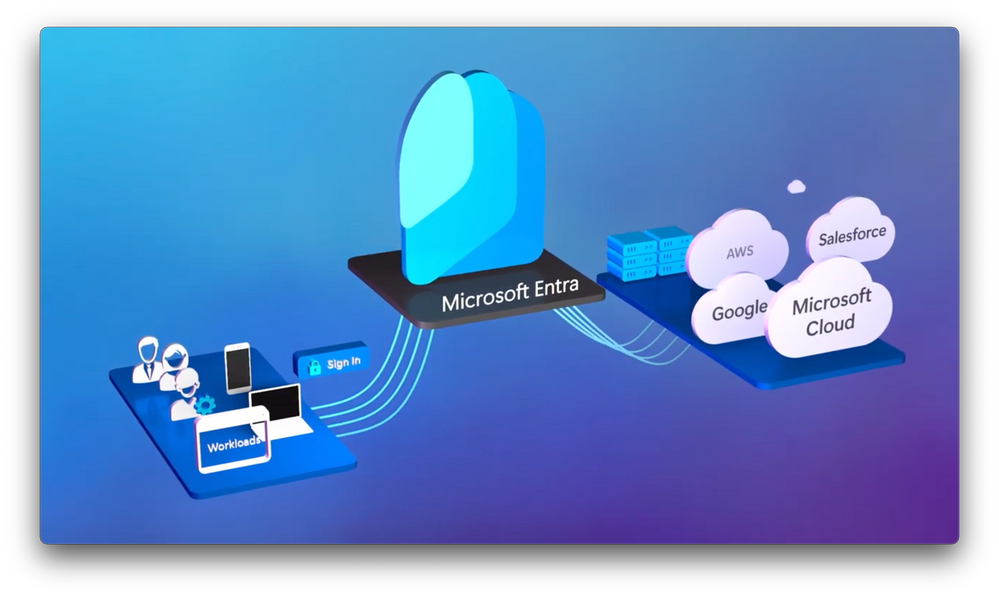
Having an effective IT strategy is essential for businesses of all sizes. Big businesses have an army of trained and experienced IT professionals who will guide them through the process. However, small and medium businesses will not. Therefore there is a need for those businesses to develop strategy either on their own or by using an external MSP (managed Service Provider) such as Operum.Tech. An IT strategy helps organizations align their technology goals with their overall business objectives and keeps them on track to achieve success.
However, creating a comprehensive and effective IT strategy can be daunting. To make it easier, I have compiled 10 steps that will help you develop an effective IT strategy for your organization. With these steps, you can ensure that your IT investments are in line with the needs of the business while helping you stay ahead of the competition.
I. Defining Goals & Objectives for a Successful IT Strategy
Developing an effective IT strategy is a game changer for businesses of all sizes. A robust IT strategy ensures that technology investments align with business objectives and helps organizations stay ahead of the curve. But how do you build such a strategy? It begins with one crucial step: defining your goals and objectives.
Defining your goals and objectives is a roadmap to the potential of your IT investments. It helps if you:
- Establish Clarity: This process brings clarity to what you aim to achieve, guiding your decision-making process to align with your objectives.
- Identify KPIs: Identifying Key Performance Indicators (KPIs) is a crucial part of this process. KPIs are essential yardsticks to measure progress over time.
- Consider Short and Long-term Goals: It’s vital to factor in both your immediate targets and your vision for the future when defining KPIs.
- Account for External Factors: External variables that could influence the achievement of your goals should also be considered.
Once the KPIs are set, it’s crucial to monitor them regularly throughout the year or project lifecycle. Frequent monitoring allows for swift adjustments to be made along the way, keeping your projects on track and propelling your business towards success.

II. Evaluate Your Current IT Infrastructure
Crafting an effective IT strategy is vital for any organization that aims to align its technology investments with its business objectives. The second step in developing such a strategy involves evaluating your existing IT infrastructure. This assessment reveals how prepared your organization is to meet its goals and uncovers any potential areas for improvement. Let’s explore why it’s critical to evaluate your current IT infrastructure and what this evaluation entails.
A comprehensive understanding of your organization’s current IT capabilities is crucial. This knowledge allows you to spot areas where additional resources or investments might be required. The following key elements should be scrutinized:
- Hardware:
Do you have the necessary servers, computers, peripherals, and network devices to support your operations effectively? For example, an e-commerce business might need robust server infrastructure to handle high traffic levels during peak shopping periods. How old is your equipment? Many businesses will hold to very old and outdated equipment. However, holding to outdated equipment creates not only a drop in performance but additionally security risks. - Software:
Assess the software solutions currently used in your business. Are they up-to-date and scalable to meet future demands? For instance, a growing business might need to consider a more sophisticated customer relationship management (CRM) system to manage increasing customer data efficiently. Same as with hardware, the software can be outdated and in many situations installing a newer version of the software is not possible due to hardware limitations. - Data Security Measures:
Is your organization’s data adequately safeguarded? An in-depth evaluation of your cybersecurity protocols is vital. For instance, a financial services provider in the UK must ensure it complies with the UK General Data Protection Regulation (UK GDPR) and the Data Protection Act of 2018. This requires robust data encryption, secure data storage solutions, and comprehensive access control mechanisms to protect client information. Utilizing the services of companies that specialize in data protection like Sophos or BullGuard, both UK-based, can be a worthwhile investment. Data Security is a wide subject and this point could be a blog post on its own. - System Integration:
How well are your systems integrated? For instance, your inventory management system should effectively communicate with your sales platform to avoid stock-out situations. - Performance Challenges:
Identify any areas where your IT systems might be slowing down operations. This could involve slow server response times or outdated software that hampers employee productivity.
By evaluating these areas, you can establish a benchmark against which you can measure future improvements. It can also aid in the creation of a roadmap for IT upgrades, ensuring your technology grows in tandem with your business.
III. Identify Areas for Improvement
Identifying areas for improvement forms a critical step in formulating an effective IT strategy. A thorough assessment of your existing IT infrastructure offers a holistic understanding of your organization’s capabilities, highlighting any gaps that need filling or areas requiring additional resources. In this section, we’ll delve into the significance of evaluating your current IT infrastructure and explain how this evaluation enables you to pinpoint crucial improvements.
- Outdated Software or Hardware:
Technology advances at a rapid pace, and falling behind can affect business performance. For instance, outdated servers may struggle to handle increasing web traffic, impacting customer experience on your online platforms. Would migrating to the cloud be a great solution, or maybe you are already in the cloud but investing in your servers could in the long run save you business money? Regularly reviewing and updating your software and hardware ensures that your IT infrastructure keeps up with the demands of your business. - Inefficient Processes:
IT should streamline operations, not hinder them. If your employees spend a lot of time manually entering data that could be automated, or your IT system is so complex that it requires constant maintenance, these are areas for improvement. Implementing more efficient software systems, such as automating data entry with AI, can boost productivity. Frequently this point is compared to bootstrapping, where you have to lift yourself by pooling your shoestrings. It is not easy, as you have to observe and question all processes. - Cybersecurity Vulnerabilities:
Cyber threats are constantly evolving, making it necessary to regularly review and update your security measures. For instance, if you’ve suffered from phishing attacks, you might need to invest in more advanced email security software or conduct cybersecurity training for your employees. Going forward, you will see that there is a growing sophistication of the attacks. Long gone are the days of a prince from the middle east that send you an email asking for help to transfer millions of dollars for a small fee written in very poor English. These days the attacks try to be as professional as they can. Frequently cybercriminals will spend time researching your business and the people who work there. - Lack of Integration:
If your business uses multiple systems that do not communicate with each other effectively, this can lead to inefficiencies and mistakes. For example, if your customer database isn’t linked to your email marketing software, you could be missing opportunities for targeted marketing campaigns. Identifying and implementing more integrated software solutions can improve performance in this area. There is a growing number of platforms that will help you automate and integrate programs that never before worked together. - Data Management:
Effective data management is essential in today’s digital age. If your organization is experiencing difficulties accessing or analysing data, this could indicate a need for improved data management systems. Implementing a robust data warehousing solution or leveraging business intelligence tools could help here.
By meticulously evaluating these areas, you can identify any deficiencies in your IT infrastructure. This knowledge empowers you to craft a more effective IT strategy, one that aligns closely with your business objectives and paves the way for operational success. Regular evaluations and timely upgrades keep you abreast of evolving tech trends, helping your IT infrastructure grow along with your business, and ensuring you maintain a competitive edge in your industry.
IV. Develop an Action Plan to Address Weaknesses
Creating an effective IT strategy is a vital step for any business aiming to optimise its operations and stay ahead of the competition. It encompasses a thorough evaluation of the current IT infrastructure, identifying areas for improvement, and crucially, formulating action plans to address any weaknesses or technological gaps. In this section, we will guide you on creating action plans that will ensure the success of your IT strategy.
- Addressing Outdated Software or Hardware:
If your evaluation reveals antiquated software or hardware, an action plan could involve scheduling regular updates or budgeting for replacements. For example, if your servers are outdated, consider migrating to cloud solutions like Microsoft Azure or Amazon Web Services, which offer scalable solutions to match your growing business needs. But if you are already in the cloud consider moving back to a local solution. There are many advantages of staying in the cloud but there are shortcomings as well and it is worth keeping an eye on and making prudent business decisions. - Streamlining Inefficient Processes:
If inefficient processes are identified, your action plan could involve investing in software that automates manual tasks or simplifies complex systems. For instance, if you’re finding it challenging to manage and execute repetitive tasks, you might consider implementing a tool like Bardeen.ai. This AI-powered platform can automate processes across various applications, freeing up your team’s time to focus on more complex tasks and boosting overall productivity. Alternatively, if integrating various business applications is proving to be a bottleneck, you could turn to a solution like Zapier. Zapier can automate workflows between different apps, allowing for a smoother flow of information and reducing manual data entry tasks, thereby enhancing efficiency and reducing the potential for errors. - Strengthening Cybersecurity:
If your cybersecurity measures have vulnerabilities, consider investing in advanced security software and training. You might use services such as Eset or AVG for improved security. Alternatively, for a comprehensive email security solution, you could consider a platform like Mimecast. Mimecast provides email management for Microsoft 365 or Google Workspace, offering protection against phishing, malware, and other email-borne threats. Also, setting up regular cybersecurity training for employees is crucial. You can use platforms like CybSafe, a UK-based cybersecurity awareness platform, to ensure your staff is well-versed in identifying and preventing potential security threats. - Enhancing System Integration:
If system integration is an issue in your small-to-medium business, your action plan should focus on ensuring seamless communication between your various IT systems. Instead of relying on complex and expensive solutions designed for large businesses, consider user-friendly platforms that are tailored to smaller businesses. For instance, tools like Zoho One offer a suite of over 40 integrated business and productivity applications for your business. Similarly, Freshworks provides a range of products from CRM to IT service management that are designed to work together. Another great solution is Zapier, which can automate workflows between different applications, improving operational efficiency, and reducing manual workload. - Improving Data Management:
If data management is a challenge, consider investing in data warehousing solutions or business intelligence tools. For instance, using a service like Google’s BigQuery for data warehousing and Tableau for data visualisation can lead to more informed decision-making.
V. Research the Latest Technologies Available
Keeping abreast of the latest technological advancements is a necessity for businesses aiming to stay competitive. From streamlining inefficient processes to fortifying cybersecurity, from enhancing system integration to improving data management – investing in the right technologies can revolutionise your organization, leading to greater success. To help you stay at the cutting edge, here are five key areas where businesses should consider exploring the latest technology solutions.
- Cloud Computing:
Services such as AWS, Google Cloud, and Microsoft Azure offer a plethora of on-demand applications, storage, and data analytics solutions. For instance, a business can migrate its on-premises servers to the cloud to reduce costs, improve scalability, and enhance data security. - Artificial Intelligence (AI):
AI tools such as Google Bard or OpenAI can automate routine tasks, streamline customer service operations, and provide valuable insights into customer behaviour. A UK-based business might use AI solutions from DeepMind, a London-based AI company, for sophisticated machine learning applications. - Cybersecurity:
Investing in advanced cybersecurity solutions helps protect your business from threats such as data breaches, ransomware, and malicious software. Smaller businesses might consider UK-based cybersecurity solutions like BullGuard or Sophos for robust protection tailored to their needs or Mimecast mentioned above for email security. - Internet of Things (IoT):
IoT technology enables businesses to gather data from various connected devices and sensors, providing deeper insights into customer behaviour. For example, a logistics company might use IoT sensors on their vehicles for real-time tracking, improving operational efficiency. The IoT platform by ARM, a UK-based technology company, is a great local option for such solutions. - Data Management:
Reliable data management tools are crucial to store, protecting, and analysing customer data effectively. Microsoft’s Power BI or Tableau are popular choices, and UK-based companies such as Panintelligence offer robust local alternatives for businesses looking to leverage data insights.
VI. Evaluate Potential Vendors and Solutions
As the digital world evolves at breakneck speed, businesses, big or small, must leverage the right technology solutions to stay in the game. Yet, with a dizzying array of options at your disposal, pinpointing the perfect vendors and solutions for your business can be like finding a needle in a haystack. I’ll arm you with key considerations – from features and services to cost-effectiveness and security – that will guide your evaluation process and lead you towards informed, strategic decisions.
- Features and Services:
Determine the exact requirements, features, and services that you need from potential vendors. It is essential to have a clear understanding of what each product or service can offer your business, including technical capabilities, scalability options, security measures, customer support services, etc.
- Cost-Effectiveness:
Compare the cost of ownership over the long term and the total cost of acquisition for different vendors. Evaluate the pricing models offered, as well as any additional one-time or recurring fees, to determine which options are most cost-effective.
- Security:
Cybersecurity is a must-have in today’s digital landscape, so be sure that selected vendors provide adequate security measures such as encryption, two-factor authentication, data loss prevention, etc.
- Customer Support:
Whether you require round-the-clock technical assistance, chatbot services or a dedicated customer service team – evaluate the customer support services that each vendor provides and make sure they align with your business needs.
By keeping these considerations in mind, you can better equip yourself to make informed decisions when selecting the right vendors and solutions for your business. With the right tools in place, you can ensure long-term success and optimal performance.
VII. Create a Budget for Your IT Strategy Implementation
It’s time to create a budget to ensure that each component of your IT strategy implementation can be funded. A well-crafted budget will help you prioritize investments and make sure that resources are allocated appropriately so your organization can achieve its desired outcomes. Read on to learn more about how to create a budget for your IT strategy implementation.
- Assess Your Current IT Infrastructure:
Your journey to future-proofing your IT infrastructure should begin with a thorough understanding of your present setup. Assess your current resources and define the budgetary allocation needed for maintenance, system upgrades, and fresh investments.
For a more precise calculation, you could choose to calculate the spend per person or per computer annually. Consider a small enterprise that opts to replace computers every three years, where each machine costs roughly £1000. This equates to a monthly expense of about £27. Additional expenses could include an Office 365 subscription (around £10 – £18 per month), antivirus protection (£2 per month), and a monthly maintenance fee of £50. Therefore, your total monthly cost per user is likely to hover between £89 – £97.
For larger corporations, this basic calculation might remain similar, though the choices can vary. Instead of sticking to Business Solutions, they might upgrade to Enterprise solutions for their IT needs. Keep in mind, these calculations are user-specific, meaning every user might not require an hour of support each month. This can lead to potential savings for your business. For instance, a team of five might only need one hour of maintenance per month, whereas a single user in a different setting could require 10+ hours monthly. Understanding these variances is key to optimizing your IT budget effectively. - Establish Your Objectives and Priorities:
With a comprehensive grasp of your present IT setup, it’s time to chart your course towards the future. The objectives and priorities mentioned in your IT strategy guide your focus and help identify key areas requiring immediate attention.
For instance, if your primary objective is to improve customer service, you might prioritize implementing a customer relationship management (CRM) tool that automates support and provides valuable customer insights.
For a small business, this might be a solution like Zoho CRM or HubSpot, both cost-effective tools that provide robust customer service capabilities. Zoho CRM cost per user per month is in the range of £12 – £42, with the sweet spot at around £20. HubSpot on the other hand offers a starter solution for £27 per user per month but then it jumps to over £1400 per month. As you can see there is a clear reason to research the platform before integrating it to ensure you can grow your business without a nasty surprise down the line.
Alternatively, if your priority is to streamline internal communication and project management, consider tools like Slack for real-time messaging or Trello for managing tasks and projects. These platforms are user-friendly and can significantly improve collaboration within your team.
In the case of enhancing data security, which should be a top priority for businesses of all sizes, consider investing in cybersecurity software and employee training. A small business might opt for cost-effective yet powerful solutions like Norton Antivirus or ESET Internet Security.
If your objective is to optimize operational efficiency, look into workflow automation tools. For instance, smaller businesses can leverage platforms like Zapier or Bardeen.ai to automate repetitive tasks across various applications.
These are just examples; your objectives and priorities will be unique to your business’s specific needs. By focusing on these areas, you can tailor your IT infrastructure to effectively support your company’s strategic goals. - Calculate Your Expenses:
Upon understanding your present infrastructure and setting future objectives, it’s time to crunch the numbers. Identify each potential expense, which might span across hardware acquisition, software licensing, employee training, and other related costs.
Let’s delve into some examples. For hardware, if you plan to replace each computer every three years at an approximate cost of £1000 per machine, this equates to a monthly cost of roughly £27 per user. Software licenses can vary widely depending on your needs. An Office 365 subscription, for example, could run you between £10 – £18 per user per month, while antivirus protection might cost around £2 per user monthly.
When budgeting for training, consider both the cost of the training program and the potential productivity loss during training hours. For instance, if you subscribe to a platform like CybSafe for cybersecurity awareness training, costs can range from £10-£30 per user per month.
Consider creating a budget based on your current team size and forecasted growth over 2-3 years. For instance, if your team of 10 is expected to double in the next two years, budgeting for a 20-person team from the onset can avoid costly system changes and upgrades down the line.
By analyzing these costs, you may find the need to reassess your plans and opt for a solution or platform that delivers the maximum benefits at a reasonable cost level. Prioritizing value for money is crucial in striking the balance between cost-effectiveness and operational efficiency. - Determine Your Funding Sources:
Having an estimated cost for your IT strategy implementation, the next crucial step is to establish where your funding will come from.
If you’re a self-funded company, you might be planning to finance the strategy from existing business revenue. However, it’s important to analyze your cash flow and ensure that diverting funds for IT infrastructure upgrades won’t disrupt other business operations.
On the other hand, if you’re relying on external sources, you might consider various options. You could apply for business loans from banks or alternative lenders, seek investment from venture capitalists or angel investors, or explore grants that support technological advancement for businesses.
For instance, in the UK, businesses can take advantage of government grants like the Small Business Grants Initiative or Research and Development Tax Credits. You might also qualify for technology-specific grants like the Innovate UK Smart Grants.
In some cases, vendors offer flexible payment plans or leasing options for their products, which can make high upfront costs more manageable. Software vendors often offer subscription models that spread the cost over time, reducing initial expenditure. Remember to consider each option’s advantages and drawbacks. The right funding sources will depend on your business size, growth stage, creditworthiness, and the potential return on investment from your IT strategy. - Create a Reasonable Timeline:
Establishing a sensible timeline is fundamental to ensure the smooth execution of your IT strategy, while also keeping the budget under control. This schedule should clearly outline when each task will begin, the duration, and its expected completion date.
For instance, if you’re planning to upgrade your computer hardware, take into account the time needed to source and purchase the equipment, configure the systems, and then install them across your organization. This could realistically take several weeks or even months, depending on the size of your company and the number of machines involved.
When it comes to software deployment, you should consider the time required for procurement, installation, testing, and addressing any bugs before the full rollout. Training staff to use new software could also take a few weeks or more, depending on the complexity of the software and the aptitude of your employees.
It’s also important to factor in potential delays. Allow buffer time for unanticipated events, such as hardware delivery delays, software compatibility issues, or extra training requirements. A contingency plan is also advisable in case of unexpected interruptions to your timeline.
A well-thought-out timeline not only helps manage expectations but also ensures that every phase of the implementation is achieved in a systematic and timely manner. - Monitor and Adjust Along the Way:
As you journey through your IT strategy implementation, some adjustments may be necessary. It’s crucial to remain vigilant about monitoring costs and timelines, ready to fine-tune your approach as circumstances dictate.
For example, if hardware installation is taking longer than anticipated, you might need to reassess your timeline or consider outsourcing to a professional service for quicker setup. If a newly adopted software is not meeting your expectations, you might consider exploring other solutions or investing in additional staff training.
Similarly, if you’re exceeding your budget, identify the areas causing the budget overrun. It may be due to underestimation of costs, unexpected expenses, or inefficiencies in execution. Upon identifying the cause, you can take corrective measures such as negotiating with vendors for better prices, finding cost-effective alternatives, or improving operational efficiency.
Establishing a budget for your IT strategy is more than just a one-time task—it’s a dynamic process that guides your resource allocation and ensures your organization can fulfil its objectives efficiently. By maintaining flexibility and a keen eye for detail, your IT strategy implementation can be a resounding success, propelling your organization towards its strategic goals.
VIII. Implement the New Systems and Processes
Bringing a new IT strategy to life can be a complex task, but with thoughtful planning and a strategic approach, it can propel your organization to new heights. The final step involves putting into action the new systems and processes that have been meticulously planned to align with your strategic objectives. This crucial phase demands precision, vigilance, and adaptability to manage any unforeseen challenges that might occur.
Remember, the transition phase may bring with it a learning curve and potential disruption to regular operations. Hence, it’s important to plan this phase during a relatively quieter period for your business, to minimize the impact of this temporary adjustment period.
Regular communication is also essential during this phase. Keep your team informed about the changes, what to expect, and how to handle potential issues. This way, everyone understands their role in the transition, promoting smoother implementation.
Monitoring the implementation process is equally vital. Regular check-ins, feedback collection, and system tests can help you spot any glitches early and rectify them before they escalate.
Ultimately, implementing your IT strategy is an ongoing process that goes beyond the initial rollout. It requires continuous monitoring, evaluation, and tweaks to ensure it keeps serving your business needs effectively and efficiently. In this blog post, we’ve shed light on how budgeting, vigilant monitoring, and proactive adjustments can ensure a successful IT strategy implementation, setting your organization on a path to achieving its strategic goals.
IX. Monitor Performance Metrics Regularly
A crucial aspect of implementing a successful IT strategy is regular monitoring of key performance indicators (KPIs). These metrics provide insightful data on how well your new systems and processes are performing, helping you identify areas of success or those needing improvement.
For instance, if you’ve implemented a new customer relationship management (CRM) system, you might monitor metrics like customer engagement, response times, or customer satisfaction scores. These metrics can help you understand whether the new system is improving customer service as intended.
Similarly, if you’ve adopted a new project management tool, you might track metrics such as project completion times, team collaboration levels, or the number of tasks completed on time. These can help you gauge if the tool is enhancing productivity and efficiency as expected.

If you have upgraded your cybersecurity measures, you might want to track incidents of security breaches, system downtime, and recovery time after incidents. These metrics can show the effectiveness of your new security measures.
Remember, monitoring should not be a one-off task. Regularly tracking these performance metrics helps ensure that your IT strategy remains aligned with your business objectives and continues delivering value. If a certain aspect of the strategy is not performing as expected, prompt identification allows for quick adjustments, minimizing potential impacts on your business operations.
Effective monitoring can provide valuable insights, drive decision-making, and ultimately contribute to the successful implementation of your IT strategy.
X. Adjust as Needed to Meet Changing Needs and Requirements
The world of technology is dynamic, with rapid advancements and changes being the norm. As such, an effective IT strategy is not set in stone but is a flexible plan that adapts to meet changing needs and requirements.
Perhaps a new technological innovation enters the market that can boost your operational efficiency more than your current systems. Maybe your business grows faster than anticipated, necessitating quicker scaling of your IT infrastructure. There could also be sudden shifts in industry regulations that require you to adjust your IT compliance measures.
In these situations, it’s important to reassess your IT strategy and make the necessary adjustments. This could mean adopting new technologies, upgrading existing systems, increasing IT training for your team, or revising your IT security policies.
For instance, if your team is struggling with a new software system, additional training or simplifying certain processes could help improve usability and efficiency. If a new cybersecurity threat emerges, you might need to upgrade your security software or conduct additional employee training on new threat detection and prevention methods.
Remember, the key to a successful IT strategy is its ability to grow and evolve with your business and the wider technology landscape. Regular reviews and adjustments will ensure that your IT strategy continues to support your business goals effectively and efficiently, now and in the future.
Conclusion
Final thoughts. The process of creating and implementing an effective IT strategy can be complex and might feel overwhelming at times. If you find yourself in such a situation, remember, you don’t have to go it alone. Having a trusted IT expert on your side can make a world of difference.
At Operum.Tech, we’re committed to guiding you through every step of the journey. The complexities we’ve discussed in this blog post are the challenges we navigate daily to help businesses like yours thrive in an increasingly digital world.
Whether you need help developing a holistic IT strategy, choosing the right tech solutions, or managing your IT infrastructure, we’re here for you. Leverage our expertise to turn these challenges into opportunities for your business growth.
Feel free to reach out to us to discuss your IT needs or any queries you may have. Let’s work together to build an IT strategy that propels your business towards its strategic goals! Contact us by clicking here!
Sign up below to join the Operum newsletter



